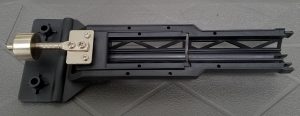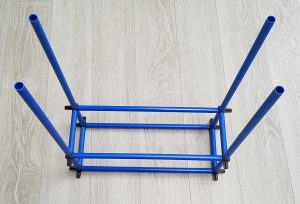Math Monday: Marble Machines
[sharethis]
Most of the objects and projects highlighted in Math Mondays to date have been relatively static: essentially sculptures that embody some elegant symmetry or underlying mathematical principle. Interest in getting some motion into our mathematical making immediately made me think of the vast array of different products designed to channel marbles to roll in intricate paths, often with a variety of bells (literally!) and whistles (well, I haven’t seen any literal ones of those). Surely there must be some interesting mathematical content in some of those kits?
Yet mathematical inspiration was hard to come by — that is, until I saw this component in the Chaos Tower marble kit. It’s called a trap; marbles roll in from the right and accumulate at the closed end of the trap on the left, until the trap is “full,” at which point the left section tips down and dumps all of the marbles out. This kind of conditional behavior, which depends on whether or not marbles are present in certain locations, lies at the heart of all computation, and should allow us to create mechanical devices that perform all sorts of mathematical actions.
It’s called a trap; marbles roll in from the right and accumulate at the closed end of the trap on the left, until the trap is “full,” at which point the left section tips down and dumps all of the marbles out. This kind of conditional behavior, which depends on whether or not marbles are present in certain locations, lies at the heart of all computation, and should allow us to create mechanical devices that perform all sorts of mathematical actions.
Moreover, one of the beauties of this particular trap is that it is adjustable; by varying the position of the silver-colored weight on the left side, we can set how many balls it takes to “fill” the trap and dump its marbles. In particular, if we adjust it so that the trap will keep one ball, but whenever a second ball arrives, it dumps both balls, then we already have in essence a one-digit binary counter: if we connect an “input” track leading to the right entry to the trap, and start with the trap empty (representing “0”), and roll successive balls down the input track, we will observe the following behavior. After one ball, there is a single ball sitting in the trap, representing “1.” After a second ball, the marbles dump out, representing a “failed carry” to a non-existent second binary digit, and there are no balls left in the trap, representing the rightmost digit of “10,” the binary representation of two.
To see this in action, we need to start by building some scaffolding using the tubes and five-way right-angled connectors in the Chaos Tower: a rectangle for the base, a short layer for rigidity,
a short layer for rigidity,


and a tall layer for room to build our machines.


Then connect in sequence the trap, a short section of straight track, and a collector scoop (as a convenient place to feed marbles in). Fasten this to the top of the scaffolding with the ball-joint connectors, and we we have our first marble machine: a one-digit binary counter.
Let’s see it actually count up to one and then overflow on the next input marble:
Although this machine may not seem too impressive yet, tune in next week to see how to string these components together to create a machine that can count exponentially higher (literally!).












